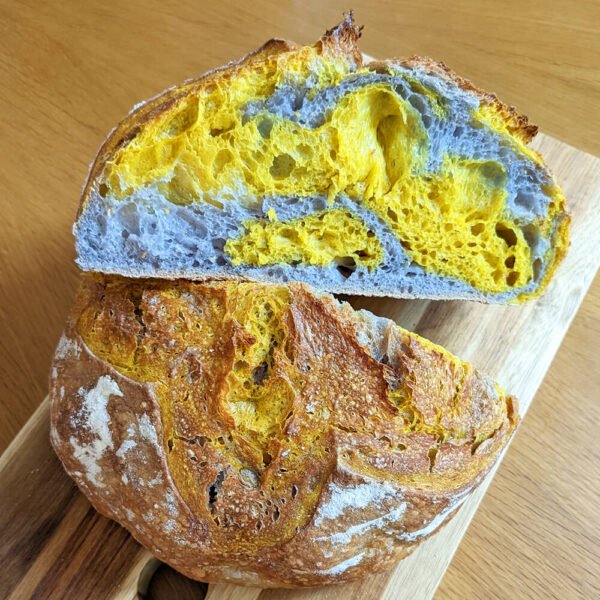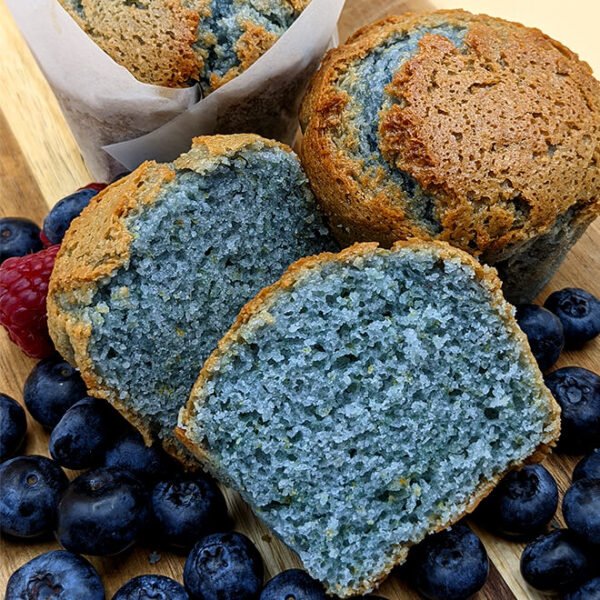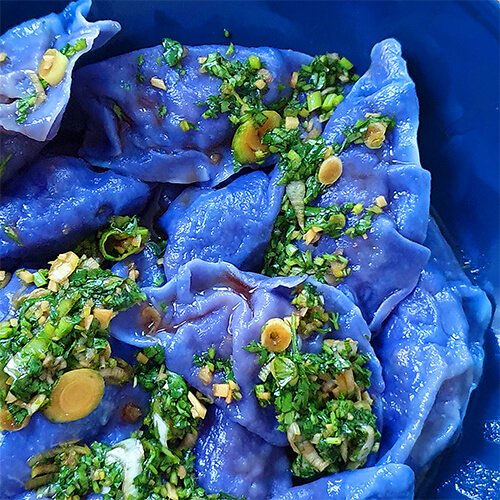Ingrédients
- 1dsp active sourdough mother culture
- 100mL filtered water (starter)
- 100g organic flour (starter)
- 150mL filtered water
- 1 heaped teaspoon turmeric powder
- 125mL strong Thé Paon butterfly pea tea (the more intense blue the better)
- 10-12g salt (depending on taste)
- 390g organic flour
- 2 large bowls, 2 spatulas
Method
Day 1 : make the starter culture. Mix the 100mL filtered water and 100g organic flour into a slurry, and stir in the sourdough culture. Cover loosely with breathable cloth (muslin or a tea towel) or plastic wrap, and leave on the bench overnight.
Preparing your turmeric water for future use is easy. Stir in 1 large teaspoonful (or more if you like) of powdered turmeric into 150mL filtered water. Place the turmeric water in the fridge overnight to rehydrate. You will only need 125mL of the bright yellow water on Day 2.
Day 2 : The overnight culture should be frothy and light – if it doesn’t look bubbly, leave for a bit longer.
Into one large bowl place 125mL of strong butterfly pea tea. Mix your turmeric water that you prepared yesterday and add 125mL of the yellow liquid into the other large bowl.
To each bowl add 5-6 grams of salt and using separate spatulas or spoons stir to dissolve. Divide your overnight starter culture evenly, and add one half to the butterfly pea bowl and the other to the tumeric bowl. Stir each bowl carefully to dilute the starter.
Add 195g flour to each bowl and combine. Cover loosely and let sit for 30 minutes so the flour can hydrate.
Gently stretch and fold each coloured mixture separately to develop the gluten, making sure to clean your hands between each colour. Let the dough sit covered in a warm place, and fold 4-6 times every now and then (i.e. every 30 minutes or whenever you remember).
When the dough is light and airy (after 3-6 hours) , tip out the butterfly pea dough onto a floured surface and stretch into a rectangle. On a different floured surface do the same for the turmeric dough. Gently pick up and transfer the turmeric dough on top of the butterfly pea dough. You will effectively have a rectangle of the two doughs stacked on top of each other.
Next, sequentially fold the sides of the butterfly pea layer over the turmeric layer to the other side of the dough rectangle – much like making a braid. You can get an idea of how to do this step on the second slide of our Instagram reel. One the small braid has been made, roll up the loaf and seal the sides (there’s a youtube video here to help). Place into a cast iron pan/cocotte, lined with baking paper, and put the lid on.
Let the dough rise until it has increased in size. If you have strong yeast and the loaf is the size you want, it’s fine to score and bake the loaf. However, most natural yeast grows slowly, so once the dough has increased in size a big, put the cast-iron pan directly into the fridge (4°C) overnight to develop the sourdough further.
Day 3 : Heat the oven up to 200°C, and take your bread pot our of the fridge. Sieve a bit of flour onto the surface and gently sooth with your hands. Score (quick, deep cuts) with a dough razor blade, and tip a dessertspoonful or two under the baking paper in the pot. Put the lid on, and bake in the oven for 30 minutes. The added water should turn into steam and help your loaf rise.
After 30 minutes, take the pot out of the oven and remove the lid. Using the baking paper, transfer the partially-cooked loaf to a baking tray. Spray the surface of your loaf with water, and put it back in the oven to cook for at least another 20 minutes. Your loaf will be ready when it has a golden crust, and makes a hollow sound when tapped.
Take the cooked loaf out of the oven and let cool on a wire rack. Your loaf should be golden on the outside, and psychedelic purple and yellow on the inside. All that’s left to do is enjoy your antioxidant-packed loaf !









